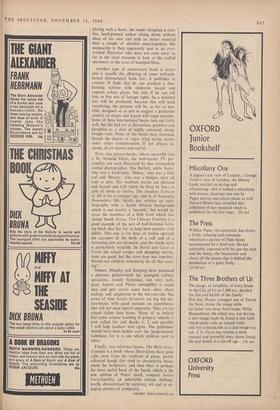Information, Please !
My Life with the Animals of Africa : The Great Plains. The Rivers and Lakes. Both by Armand Denis. Photographs by Des Bartlett. (Collins, 12s. 6d. each.)
The Bible Encyclopedia for Children. By Cecil Northcott. Illustrations by Denis WrigleY. (Lutterworth, 21s.) BOOKS of information for children are more than ever needed today. This is partly because some version of the Project method is much used in schools, so that an individual child or a grouP of children is constantly being set to look some aspect of a subject and then to communi- cate the result to the rest of the class. RightlY, the junior departments of schools and public libraries cater for this. Also many parents novv take an almost desperate interest in their children's scholastic progress and comb libraries and bookshops for books that will be not onlY agreeable but a help with homework.
So the geography lesson May lead the child to some book about a pet lion or an infant crocodile, and physics and chemistry to bio- graphies of Rutherford or Lavoisier. Ccrise' quently, children's reference books, or pleasanti produced versions of what used to be call 'supplementary reading,' are in demand. So publishers respond with large, expensive, threw. colour picture-books, others with books that ari more compact, have line drawings and 1 moderately priced. Naturally, though the genera idea is excellent, not all such books are good! and we reviewers, whose space is usually rigittlY• limited, tend to draw a veil of silence over the worst of them. But we know that, alas! sonic of those that purport to be about science are positively erroneous, a large part of the inforrna- tion, given being contrary to fact. In contor
plating such a book, the reader imagines a care- less, hard-pressed author sitting down without ideas of his own and with no better material than a couple of obsolete encyclopedias. His manuscript is then apparently sent to an over- worked illustrator who does not even totter as far as the local museum to look at the stuffed specimens or the cases of knapped flints.
Another type of unnecessary book is newer and is usually the offspring of some well-pub- licised international book fair. A publisher in country X finds that he can produce a fine- looking volume with elaborate layout and copious colour plates, but only if he can sell four or five sets of foreign rights. So a minimal text will be produced, because this will need translating, the pictures will be, as far as pos- sible, designed so as not to suggest a particular country of origin and layout will reign supreme. Some of these international books turn out fairly well, but the bad are as flavourless, pointless and deceptive as a slice of highly coloured, cheap, bought cake. None of the books here reviewed, though the degree of sugar icing varies, comes under either condemnation. If not always in- spired, all are honest and useful.
First, two picture-books, whose agreeable text is by Armand 'Denis, the well-known TV per- sonality, are each illustrated by that outstanding animal photographer, Des Bartlett, while 'Sarni,'
who was a bush-baby, who was a little owl and 'Brocky,' who was a badger, were all kept as pets. The resultant stories are pleasant and factual and will rightly be liked by boys or girls of seven to twelve. The Smallest Tortoise of All is for a younger age, and in A Naturalist Remembers Mr. Skaife has written an auto- biography with a South African background which is not exactly a 'juvenile,' but would in- terest the members of a fifth form which was 'doing' South Africa. Tim Chooses Farming is :1 good example of the sort of half-fictional farm- ing book that has for so long been popular with adults. This one is for boys of twelve upward, the accounts of the birth of a calf and of a farrowing sow are dramatic, and the whole story is particularly readable. In David and Carol as Cooks the actual recipes and shopping instruc- tions are good, but the story -does not, convince. Would two children voluntarily do all that cook- ing?
Messrs. Murphy and Keeping have produced a pleasant picture-book for youngish railway specialists, mainly historical, not very tech- nical. Insects 'and Plants exemplifies a sound idea and gets across some basic ideas about ecology and adaptation to the ten-year-old. The series of four Junior Scientists are big flat pic- ture-books with good sections on experiments that will not need special apparatus. They are for school rather than home: Many of us believe that some science teaching in primary schools is now called for and Books 1, 2 and possibly 3 will help teachers who agree. The publishers should have been bolder over the 'programmed' technique, for it is one which children tend to enjoy.
Finally, two reference books. The Bible Ency- cloptedia is a book whose illustrations have gone right away from the tradition of pious, pastel- coloured dough that used to characterise books about the Scriptures; and then what is perhaps the most useful book of the batch, which is the new edition of Pears' small, compact Junior Encycloptedia, an admirable sixteen shillings' worth, characterised by accuracy, wit and an en- gaging absence of pomposity.
AMABEL WILL1AMS-ELLIS











































 Previous page
Previous page